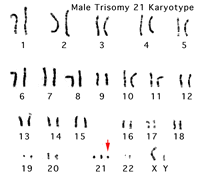Trisomy 21: Difference between revisions
No edit summary |
|||
| Line 2: | Line 2: | ||
[[Image:Trisomy21arrow.gif|left]] Down syndrome or trisomy 21 is caused by nondisjunction of chromosome 21 in a parent who is chromosomally normal and is one of the most common chromosomal abnormalities in liveborn children. The frequency of trisomy 21 in the population is approximately 1 in 650 to 1,000 live births, in Australia between 1991-97 there were 2,358 Trisomy 21 (Down) infants. | [[Image:Trisomy21arrow.gif|left]] Down syndrome or trisomy 21 is caused by nondisjunction of chromosome 21 in a parent who is chromosomally normal and is one of the most common chromosomal abnormalities in liveborn children. The frequency of trisomy 21 in the population is approximately 1 in 650 to 1,000 live births, in Australia between 1991-97 there were 2,358 Trisomy 21 (Down) infants. | ||
'''Aneuploidy''' is the term used to describe any abnormal number of chromosomes either an increase or decrease in total number. | |||
Recent attention has focussed on screening for Down's syndrome (mainly in terms of cost and efficiency) during fetal life with over 350 articles in the medical literature in just the past five years. There is also a high correlation of [[Genetic_risk_maternal_age|increased genetic risk with maternal age]]. | Recent attention has focussed on screening for Down's syndrome (mainly in terms of cost and efficiency) during fetal life with over 350 articles in the medical literature in just the past five years. There is also a high correlation of [[Genetic_risk_maternal_age|increased genetic risk with maternal age]]. | ||
Revision as of 13:55, 5 August 2009
Introduction
Down syndrome or trisomy 21 is caused by nondisjunction of chromosome 21 in a parent who is chromosomally normal and is one of the most common chromosomal abnormalities in liveborn children. The frequency of trisomy 21 in the population is approximately 1 in 650 to 1,000 live births, in Australia between 1991-97 there were 2,358 Trisomy 21 (Down) infants.
Aneuploidy is the term used to describe any abnormal number of chromosomes either an increase or decrease in total number.
Recent attention has focussed on screening for Down's syndrome (mainly in terms of cost and efficiency) during fetal life with over 350 articles in the medical literature in just the past five years. There is also a high correlation of increased genetic risk with maternal age.
Trisomy 21 (Down Syndrome) Karyotypes
The normal human karyotypes contain 22 pairs of autosomal chromosomes and one pair of sex chromosomes. The karyotype is the characteristic chromosome complement as identified by staining and can only be identified during cell division when chromosomes are folded. The chromosomes when organised as an image in sequence are called a karyogram or idiogram.
Associated Congenital Abnormalities
- neurological (mental retardation)
- characteristic facies
- heart (atrioventricular canal)
- gastrointestinal tract (duodenal stenosis or atresia, imperforate anus, and Hirschsprung disease)
- leukemia (ALL and AML)
- hearing loss (90% of all patients)
- musculoskeletal (limb abnormalities, hypotonia, joint hypermobility, ligamentous laxity, spine anomolies, scoliosis)
- Acute megakaryocytic leukemia occurs 200 to 400 times more frequently in Down syndrome.
Hearing loss is usually of the conductive type. (More? Hearing Abnormalities)
Musculoskeletal include bony anomalies of the cervical spine (produce atlanto-occipital and cervical instability), scoliosis, hip instability, slipped capital femoral epiphysis, patellar instability, and foot deformities. (modified musculoskeletal list from Caird etal., 2006)
Heart Defects
Congenital heart defects are common (40 to 50%) in Down’s babies and are a common cause of postnatal death.
Approximately 30 to 40% have complete atrioventricular septal defects (early diagnosis generally allows corrective surgery to be performed).
- endocardial cushion defect (43%)
- ventricular septal defect (32%)
- secundum atrial septal defect (10%)
- tetralogy of Fallot (6%)
- patent ductus arteriosus (16%)
Limb Defects
- Hand - features short and broad hands, clinodactyly (curving of the fifth finger, little finger) with a single flexion crease (20%), hyperextensible finger joints.
- Foot - space between the great toe (big) and the second toe is increased.
- Hip - acquired hip dislocation (6%).
(More? Limb Abnormalities)
American College of Obstetricians and Gynecologists Recommendations
The following ACOG recommendations (January 2007) are based on good and consistent scientific evidence:
- First-trimester screening using both nuchal translucency (NT), an ultrasound exam that measures the thickness at the back of the neck of the fetus, and a blood test is an effective screening test in the general population and is more effective than NT alone.
- Women found to be at increased risk of having a baby with Down syndrome with first-trimester screening should be offered genetic counseling and the option of CVS or mid-trimester amniocentesis.
- Specific training, standardization, use of appropriate ultrasound equipment, and ongoing quality assessment are important to achieve optimal NT measurement for Down syndrome risk assessment, and this procedure should be limited to centers and individuals meeting this criteria.
- Neural tube defect screening should be offered in the mid-trimester to women who elect only first-trimester screening for Down syndrome.
Text extract from: New Recommendations for Down Syndrome Call for Screening of All Pregnant Women (press release January 2, 2007)
UNSW Embryology Links
Glossary Links
A | B | C | D | E | F | G | H | I | J | K | L | M | N | O | P | Q | R | S | T | U | V | W | X | Y | Z
- Dr Mark Hill 2009, UNSW Embryology ISBN: 978 0 7334 2609 4 - UNSW CRICOS Provider Code No. 00098G


